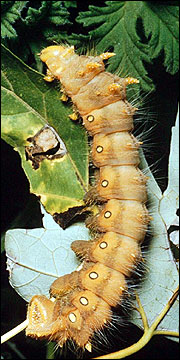Imperial moth
Royal moths and silkworm moths
 Imperial moth caterpillars (Eacles imperialis) are present from June to August. They produce two generations per year. Common host plants include oaks, sweetgum, maple, hickory, sassafras, elm and sycamore.
Imperial moth caterpillars (Eacles imperialis) are present from June to August. They produce two generations per year. Common host plants include oaks, sweetgum, maple, hickory, sassafras, elm and sycamore.
The body color of imperial moth varies from light green to dark green to reddish brown. Full-grown larvae reach lengths of 4 inches. The head is usually yellow-orange. Four short horns are found on the second and third thoracic segments and on the last two abdominal segments. The rest of the body is sparsely covered with long, white hairs. The round-oval spiracles on the sides of each abdominal segment are conspicuous. They are white-yellow outlined in black.
About the family
Royal moths and silkworm moths of the Saturniidae family include many of the largest and most colorful moths in North America and the world. These large caterpillar species are usually not considered pests. Although a single individual can consume relatively large amounts of foliage, their numbers rarely reach levels that would warrant control. But there are a few species that can do significant damage to many forest tree species. Upon completing their larval development, most saturniid caterpillars will pupate in large, tough silken cocoons usually attached to twigs or leaves or found on the ground. Many species have only one generation per year.